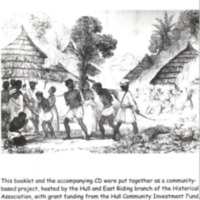
Songs of Slavery
The Songs of Slavery CD and booklet were produced by a community-based project, led by the Hull and East Riding branch of the Historical Association. The project was part of the Wilberforce 2007 initiative in Hull. Songs of Slavery recorded 19 songs relating to slavery, alongside six short narratives. Most of the songs date from the mid-19th century and were originally composed and sung by enslaved peoples. Some were based on religious beliefs, others also contained coded messages to aid escape and resistance. The Songs of Slavery tracks were sung or narrated by local choirs, singers and musicians, together with students from local schools and colleges.
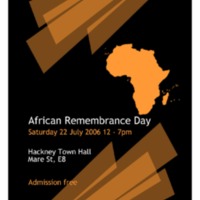
The Ligali organisation, 2007
Ligali is a Pan-African human rights organisation that challenges the misrepresentation of African people, culture and history in the British media. It produced various responses to promote the African perspective of the 2007 bicentenary, including their 'Declaration of Protest to the 2007 Commemoration' expressing dissatisfaction with much of the terminology and focus of the 'official' commemorations. Their particular focus was on the ‘Maafa’, derived from the Kiswahili word meaning ‘great disaster’, and referring to the ongoing impact of enslavement and colonialism for African peoples. The publication ‘Addressing Maafa denial and slavery apologists’ was a guide to promoting the truth about the Maafa from an Africentric position.
‘Maafa: Truth 2007’ is a documentary film directed by the Ligali founder, Toyin Agbetu, and produced by Ligali’s then head of media affairs, emma pierre. The film confronts some of the myths about British slavery, featuring contributions from community activists, project workers, teachers and the African British business community. The film was screened at various events, including African Remembrance Day at Hackney Town Hall in 2006. Ligali’s ‘Freedom Fighter’ stamps were designed by Emma Pierre-Joseph as a response to the Royal Mail’s publication of six stamps to mark the bicentenary. ‘The Walk’ is a documentary record of Toyin Agbetu’s protests at the service at Westminster Abbey to mark the bicentenary on 27 March 2007.
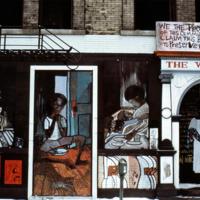
Wall of Truth
Although sharing an address with the famous Wall of Respect, the Wall of Truth was different. Whilst the Wall of Respect exalted black role models, leaders and liberators, the Wall of Truth wove negative scenes of poverty, brutality and racism into the fabric of the urban environment. Rather than promoting racial pride, it highlighted racial disparities. “The intent on the opposite side [of the road] was that things had gone more militant,” muralist Eugene Wade explained: “more blackness was needed in terms of representing the Black Power symbol and the whole thrust of what was happening in the black community.” Wade notes that “people were getting angry and fed up, so what we were trying to do was implement the attitude and the mood."The Wall of Truth was a significantly larger mural than its Chicago neighbour, the Wall of Respect. It spanned the length of an apartment building, and wrapped around onto an adjoining wall. It contained nine separate narrative panels and was one of the first instances that a radical black past was visualised in the streets through the antislavery leaders Frederick Douglass and Nathaniel Turner, as well as Mary McLeod Bethune, W.E.B. Du Bois, H. Rap Brown, Stokely Carmichael, Marcus Garvey, Huey P. Newton, Fred Hampton, and Malcolm X.
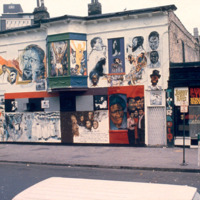
Wall of Respect
The Wall of Respect was the first exterior African American mural in the United States. Painted by OBAC (Organisation of Black American Culture), it underwent three main phases, as shown throughout the photographs here. Its creation was an inclusive process, asking local residents to decide which black heroes should be included in the mural. This was an integral step in the mural-making process because “any muralist who’s doing anything of a thoughtful nature should always have an input from the community,” artist Bill Walker observed. “You can’t do things that make people think they’re not a part of things.” Compiling a newsletter and consulting local militant street gangs, OBAC wrote a list of historic and contemporaneous figures to be memorialised on the wall, before waiting for their approval. “The militant [members of the community] were the ones that defined who would go on the wall and who would not,” artist Eugene Eda Wade remembers in a 2017 oral history interview. The choices were figures from the past and present who “charted their own course” through life and “did not compromise their humanity,” including the antislavery leader Nathaniel Turner, as well as James Brown, James Baldwin, Thelonious Monk, Malcolm X, Nina Simone, Claudia McNeil, Stokely Carmichael, H. Rap Brown, Elijah Muhammad, Gwendolyn Brooks and Muhammad Ali. By celebrating radical black heroes of the past and present, the mural became a site of black cultural heritage and an unofficial landmark on Chicago’s southside. It also catalysed a national mural movement, with more than 300 murals painted in Chicago alone over the next few decades. In 1971, the mural was destroyed in a fire.
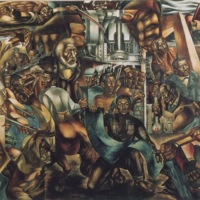
The Contribution of the Negro to Democracy in America
In 1941, the artist Charles White was awarded $2000 from the Julius Rosenwald Fellowship for an ambitious project that included the creation of Contribution of the Negro to Democracy in America. Two years later, he unveiled the mural at the Hampton Institute in Virginia.The central figure has chains around his wrists that also loop around the necks of three other figures. But the shackles on the figure’s wrists are ready to be broken by the abolitionists: Frederick Douglass, Nathaniel Turner, Denmark Vesey, Harriet Tubman and Peter Still.